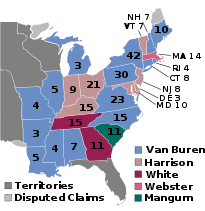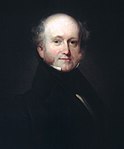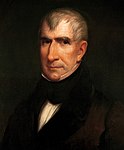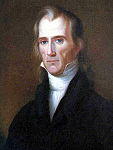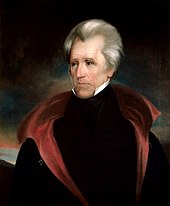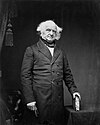
Martin Van Buren was an American lawyer, diplomat, and statesman who served as the eighth president of the United States from 1837 to 1841. A primary founder of the Democratic Party, he served as New York's attorney general and U.S. senator, then briefly as the ninth governor of New York before joining Andrew Jackson's administration as the tenth United States secretary of state, minister to Great Britain, and ultimately the eighth vice president when named Jackson's running mate for the 1832 election. Van Buren won the presidency in 1836 against divided Whig opponents. Van Buren lost re-election in 1840, and failed to win the Democratic nomination in 1844. Later in his life, Van Buren emerged as an elder statesman and an important anti-slavery leader who led the Free Soil Party ticket in the 1848 presidential election.

The Twelfth Amendment to the United States Constitution provides the procedure for electing the president and vice president. It replaced the procedure in Article II, Section 1, Clause 3, under which the Electoral College originally functioned. The amendment was proposed by Congress on December 9, 1803, and was ratified by the requisite three-fourths of state legislatures on June 15, 1804. The new rules took effect for the 1804 presidential election and have governed all subsequent presidential elections.
The Whig Party was a political party that existed in the United States during the mid-19th century. Alongside the slightly larger Democratic Party, it was one of the two major parties in the United States between the late 1830s and the early 1850s as part of the Second Party System. Four presidents were affiliated with the Whig Party for at least part of their terms. Other prominent members of the Whig Party include Henry Clay, Daniel Webster, Rufus Choate, William Seward, John J. Crittenden, and John Quincy Adams. The Whig base of support was centered among entrepreneurs, professionals, planters, social reformers, devout Protestants, and the emerging urban middle class. It had much less backing from poor farmers and unskilled workers.

The 1832 United States presidential election was the 12th quadrennial presidential election, held from Friday, November 2 to Wednesday, December 5, 1832. Incumbent president Andrew Jackson, candidate of the Democratic Party, defeated Henry Clay, candidate of the National Republican Party.

The 1840 United States presidential election was the 14th quadrennial presidential election, held from Friday, October 30 to Wednesday, December 2, 1840. Economic recovery from the Panic of 1837 was incomplete, and Whig nominee William Henry Harrison defeated incumbent President Martin Van Buren of the Democratic Party. The election marked the first of two Whig victories in presidential elections, but was the only one where they won a majority of the popular vote. This was the third rematch in American history, which would not occur again until 1892.
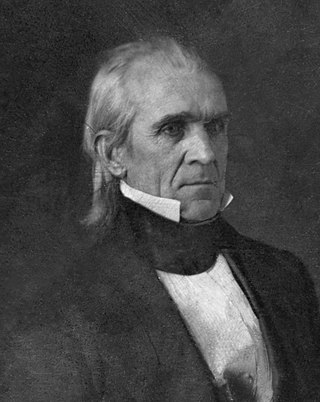
The 1844 United States presidential election was the 15th quadrennial presidential election, held from Friday, November 1 to Wednesday, December 4, 1844. Democrat James K. Polk narrowly defeated Whig Henry Clay in a close contest turning on the controversial issues of slavery and the annexation of the Republic of Texas. This is the only election in which both major party nominees served as Speaker of the House at one point, and the first in which neither candidate held elective office at the time.

The 1848 United States presidential election was the 16th quadrennial presidential election, held on Tuesday, November 7, 1848. In the aftermath of the Mexican–American War, General Zachary Taylor of the Whig Party defeated Senator Lewis Cass of the Democratic Party.

Willie Person Mangum was an American politician and planter who served as U.S. Senator from the state of North Carolina between 1831 and 1836 and between 1840 and 1853. He was one of the founders and leading members of the Whig party, and was a candidate for president in 1836 as part of the unsuccessful Whig strategy to defeat Martin Van Buren by running four candidates with local appeal in different regions of the country.
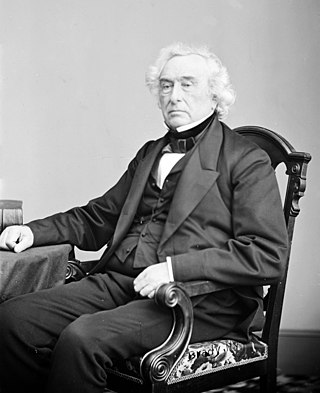
Francis Granger was an American politician who represented Ontario County, New York, in the United States House of Representatives for three non-consecutive terms. He was a leading figure in the state and national Whig Party, particularly in its moderate-conservative faction. He served as a Whig vice presidential nominee on the party's multi-candidate 1836 ticket and, in that role, became the only person to ever lose a contingent election for the vice presidency in the U.S. Senate. He also served briefly in 1841 as United States Postmaster General in the cabinet of William Henry Harrison. In 1856, he became the final Whig Party chairman before the party's collapse, after which he joined the Constitutional Union Party.

The 1832 Democratic National Convention was held from May 21 to May 23, 1832, in Baltimore, Maryland. In the first presidential nominating convention ever held by the Democratic Party, incumbent President Andrew Jackson was nominated for a second term, while former Secretary of State Martin Van Buren was nominated for vice president.
The 1835 Democratic National Convention was held from May 20 to May 22, 1835, in Baltimore, Maryland. The convention nominated incumbent Vice President Martin Van Buren for president and Representative Richard Mentor Johnson of Kentucky for vice president.

The presidency of Martin Van Buren began on March 4, 1837, when Martin Van Buren was inaugurated as President of the United States, and ended on March 4, 1841. Van Buren, the incumbent vice president and chosen successor of President Andrew Jackson, took office as the eighth United States president after defeating multiple Whig Party candidates in the 1836 presidential election. A member of the Democratic Party, Van Buren's presidency ended following his defeat by Whig candidate William Henry Harrison in the 1840 presidential election.

The 1836 United States presidential election in Georgia took place between November 3 and December 7, 1836, as part of the 1836 United States presidential election. Voters chose 11 representatives, or electors to the Electoral College, who voted for president and vice president.
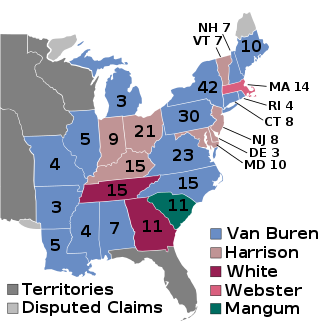
The 1836 United States elections elected the members of the 25th United States Congress. The election saw the emergence of the Whig Party, which succeeded the National Republican Party in the Second Party System as the primary opposition to the Democratic Party. The Whigs chose their name in symbolic defiance to the leader of the Democratic Party, "King" Andrew Jackson, and supported a national bank and the American System. Despite the emergence of the Whigs as a durable political party, Democrats retained the presidency and a majority in both houses of Congress.

In 1840, William Henry Harrison was elected President of the United States. Harrison, who had served as a general and as United States Senator from Ohio, defeated the incumbent president, Democrat Martin Van Buren, in a campaign that broke new ground in American politics. Among other firsts, Harrison's victory was the first time the Whig Party won a presidential election. A month after taking office, Harrison died and his running mate John Tyler served the remainder of his term, but broke from the Whig agenda, and was expelled from the party.
The history of the United States Whig Party lasted from the establishment of the Whig Party early in President Andrew Jackson's second term (1833–1837) to the collapse of the party during the term of President Franklin Pierce (1853–1857). This article covers the party in national politics. For state politics see Whig Party.
